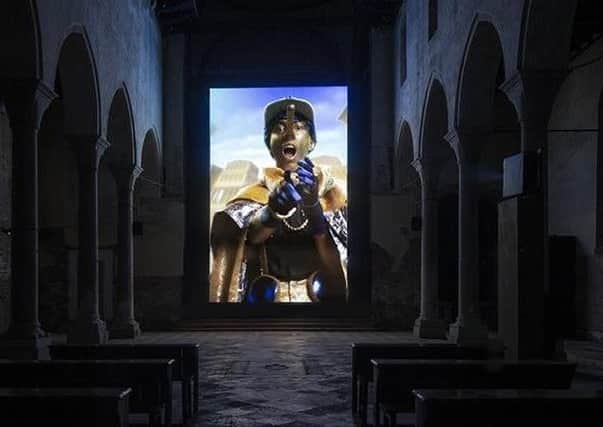Art review: Rachel Maclean - Spite Your Face


Rachel Maclean: Spite Your Face ****
Chiesa di Santa Caterina, Canareggio, Venice
The building is otherwise empty apart from a spotlit statue of St Catherine of Alexandria, a smart woman tortured, and ultimately sacrificed, on the orders of a powerful man. Once this church was run by a mendicant order dedicated to a vow of poverty. Later it became a nunnery, a posh prison for daughters of the nobility when Venice dowries became unaffordable.
All of this matters, for Maclean’s film pits rich against poor, truth against fake news and men against women in a gorgeous, funny and at times deeply disturbing tale of an urchin’s rise and fall – one that turns out to be as incandescent with rage as it is glittering with cheap gilt and diamanté.
Advertisement
Hide AdAdvertisement
Hide AdPic’s ascent from street life in a dark, medieval city, populated by ragged paupers in shattered shellsuits, to a world above, which is a digital Vitruvian city with the lifestyle of a contemporary Versailles, is characterised by his moral descent into untruth, demagoguery and sexual violence.
As ever, thanks to green screen technology, extraordinary costumes, a prosthetic designer who worked on the Harry Potter franchise and an unrivalled work ethic, Maclean plays and mimes all the parts herself. This time her script is voiced by actors whose vocal ranges shift from Trumpian drawl to Nigel Farage’s bar room baritone.
Maclean is the Blue Fairy, a character from Carlo Collodi’s original 19th century story of Pinocchio and who, in this version, oscillates between a maternal Virgin Mary and Donatella Versace run to seed. In examining fairy tale types and misogynist stereotypes Maclean doesn’t flinch. She is also Pic himself and a sinister, slavering Machiavelli who runs a posh boutique called Spite Your Face, which seems to sell snake oil as well as hideous and expensive shoes.
In the film the swipe of a credit card quickly morphs into an image of a blade on human flesh. Consumerism, she suggests, is a pervasive and damaging form of self-harm. Pic becomes the face of a fashionable perfume, named Untruth, but his wealth and growing political influence can do nothing to disguise the stench of his corruption. When it comes to the film’s traumatic and violent scenes Maclean is both victim and perpetrator, and the film is structured on an endless loop. Pic is caught in endless cycles of aspiration and desperation.
In her recent films such as Feed Me, now in the collection of the Scottish National Gallery of Modern Art, Maclean has favoured a candy coloured palette, and the shiny emoji imagery of the social media age. Here she is influenced by the lapis lazuli gleam of Venice’s historic paintings and the glittering night skies of the city in winter. She wrote the film, shortly after Trump’s election, in December 2016.
In Venice you can’t escape the churches, nor their contemporary equivalent, the tiny temples to Prada and Gucci, which line the streets. Maclean’s extraordinary post-production techniques draw easy parallels between different forms of worship. The World Above is dominated by the kind of supercharged three-dimensional realism that fuses late Renaissance painting with Call of Duty. The World Below is a clever pastiche of flattened medieval perspectives. Maclean is a unique talent and her marvellous and disturbing vision takes you both to Heaven and Hell.
*Until 26 November